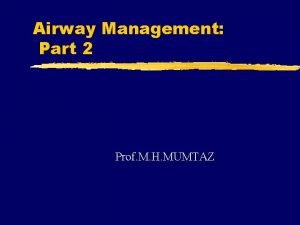MRI evaluation of posttracheostomy tracheal stenosis in adult

- Slides: 1

MRI evaluation of post-tracheostomy tracheal stenosis in adult ICU survivors Dr Joel Meyer, ST 6 Acute Medicine and Intensive Care Medicine. Dr Ben Griffiths, ST 4 Anaesthetics and Intensive Care Medicine. Dr Carl Waldmann, Consultant Intensivist and Anaesthetist Introduction Critically ill patients undergoing tracheostomy are at risk of developing subsequent tracheal stenosis. The true incidence remains unclear due to lack of routine follow up in the majority of units. Norwood et al found 31% had >10% tracheal stenosis post percutaneous tracheostomy(1). Incidence has reduced since the introduction of low pressure cuffs(2) In RBH, all post-tracheostomy ICU patients attending rehabilitation after intensive care clinic are offered MRI to determine presence of tracheal narrowing. This study aimed to establish the incidence and magnitude of tracheal stenosis encountered in this cohort of general adult ICU survivors. Method We searched the ICU operating system Carevue for all patients ventilated via tracheostomy over a five year period from January 2010 to December 2014 inclusive. From patients identified we cross-referenced this with the radiology viewing program Web Centricity. Our analysis of tracheal stenosis was from the radiologists' reports. The reports were classified by investigators into four categories (see table 1) The notes of these patients were then reviewed. Results 389 general ICU patients were ventilated via tracheostomy over the five year period. 63 decannulated survivors underwent follow-up MRI. Complete radiological and clinical records were available for 59 of these patients. Median age was 58 years. Median duration of tracheostomy was 11 days. Three patients (5%) were found to have significant tracheal stenosis. MRI report group/ Trache technique NAD PN MN Sig TS Percutaneous 36 1 3 2 Surgical 14 0 1 1 Had tracheostomy n = 389 Had MRI n = 63 Complete records* n = 59 Percutaneous n = 42 No MRI n = 326 Incomplete record n=4 * Unknown tracheostomy technique. n = 1 Surgical (RBH) n=8 Surgical (other hospital) n=8 Figure 1. Flow Diagram of study Discussion Our findings provide welcome reassurance to both practitioners performing tracheostomies and those contemplating airway management in previous tracheostomised adult patients. However, the presence of significant tracheal stenosis in 5% of asymptomatic patients brings into question the need for standardisation of further investigation following tracheostomy on general adult ICU. NAD – No tracheal stenosis; PN – Possible narrowing; MN – Minor narrowing; Sig TS – Significant tracheal stenosis References: (1) Incidence of tracheal stenosis and other late complications after percutaneous tracheostomy. Ann Surg. 2000 Aug; 232(2): 233– 241. (2) Stauffer JL, Olson DE, Petty TL. Complications and consequences of tracheal intubation and tracheostomy. A prospective study of 150 critically ill adult patients. Am J Med. 1981; 70: 65– 76

